Physical Alteration and Color Change of Granite Subjected to High Temperature
Abstract
:1. Introduction
2. Materials and Methods
3. Results and Discussion
4. Conclusions
Author Contributions
Funding
Institutional Review Board Statement
Informed Consent Statement
Acknowledgments
Conflicts of Interest
References
- Neumann, P.A. The geological disposal of nuclear waste. J. Environ. Radioact. 1988, 6, 92–94. [Google Scholar] [CrossRef] [Green Version]
- Freiesleben, H. Final disposal of radioactive waste. In Proceedings of the EPJ Web Conference, Varenna, Italy, 30 July–4 August 2012; Volume 54, p. 1006. [Google Scholar] [CrossRef] [Green Version]
- Chapman, N.; Hooper, A. The Disposal of Radioactive Wastes Underground. In Proceedings of the Geologists’ Association 2012. Volume 123, pp. 46–63. Available online: https://www.sciencedirect.com/science/article/abs/pii/S0016787811000940 (accessed on 17 September 2021). [CrossRef]
- Geological Society of London. Geological Disposal of Radioactive Waste. A Policy Briefing Note from the Geological Society of London. The Briefing Note. 2020. Available online: https://www.geolsoc.org.uk/~/media/shared/documents/policy/briefing%20notes/geological%20disposal%20radioactive%20waste%20policy%20briefing%20note.pdf?la=en (accessed on 15 September 2021).
- Istovics, K.; Tóth, M.T. Fracture network modeling around the Radioactive Waste Repository in Bátaapáti, based on BN2-1 pre-boring. In Mérnökgeológia-Kőzetmechanika; Török, Á., Görög, P., Vásárhelyi, B., Eds.; Hantken Kiadó: Budapest, Hungary, 2016; pp. 119–128. [Google Scholar]
- Balla, Z.; Gyalog, L.A. Mórágyi-Rög Eszakkeleti Részének Földtana. Magyarázó a Mórágyi-rög ÉK-i Részének Földtani TérképsoRozatához (1:10 000); (in Hungarian, translated title: Geology of the north-eastern part of the Mórágy Block: Explanatory notes to the geological map-series of the north-eastern part of the Mórágy Block (1:10 000)); Magyar Állami Földtani Intézet: Budapest, Hungary, 2009; Volume 15–17, pp. 58–69. [Google Scholar]
- Martinho, E.; Dionisio, A. Assessment Techniques for Studying the Effects of Fire on Stone Materials: A Literature Review. Int. J. Archit. Herit. 2020, 14, 275–299. [Google Scholar] [CrossRef]
- Ozguven, A.; Ozcelik, Y. Effects of high temperature on physico-mechanical properties of Turkish natural building stones. Eng. Geol. 2014, 183, 127–136. [Google Scholar] [CrossRef]
- Brotóns, V.; Tomás, R.; Ivorra, S.; Alarcón, J.C. Temperature influence on the physical and mechanical properties of a porous rock: San Julian’s calcarenite. Eng. Geol. 2013, 167, 117–127. [Google Scholar] [CrossRef]
- Tian, H.; Kempka, T.; Yu, S.; Ziegler, M. Mechanical Properties of Sandstones Exposed to High Temperature. Rock Mech. Rock Eng. 2016, 49, 321–327. [Google Scholar] [CrossRef]
- Sirdesai, N.N.; Singh, T.N.; Pathegama Gamage, R. Thermal alterations in the poro-mechanical characteristic of an Indian sandstone—A comparative study. Eng. Geol. 2017, 226, 208–220. [Google Scholar] [CrossRef]
- Li, Y.; Zhai, Y.; Wang, C.; Meng, F.; Lu, M. Mechanical properties of Beishan granite under complex dynamic loads after thermal treatment. Eng. Geol. 2020, 267, 105481. [Google Scholar] [CrossRef]
- Heuze, F.E. High-temperature mechanical, physical and Thermal properties of granitic rocks—A review. Int. J. Rock Mech. Min. Sci. Geomech. Abstr. 1983, 20, 3–10. [Google Scholar] [CrossRef]
- Fan, L.F.; Wu, Z.J.; Wan, Z.; Gao, J.W. Experimental investigation of thermal effects on dynamic behavior of granite. Appl. Therm. Eng. 2017, 125, 94–103. [Google Scholar] [CrossRef]
- Siegesmund, S.; Sousa, L.; Knell, C. Thermal expansion of granitoids. Environ. Earth Sci. 2018, 77. [Google Scholar] [CrossRef]
- Shang, X.; Zhang, Z.; Xu, X.; Liu, T.; Xing, Y. Mineral Composition, Pore Structure, and Mechanical Characteristics of Pyroxene Granite Exposed to Heat Treatments. Minerals 2019, 9, 553. [Google Scholar] [CrossRef] [Green Version]
- Martínez-Ibáñez, V.; Garrido, M.E.; Hidalgo Signes, C.; Tomás, R. Micro and macro-structural effects of high temperatures in Prada limestone: Key factors for future fire-intervention protocols in Tres Ponts Tunnel (Spain). Constr. Build. Mater. 2021, 286, 122960. [Google Scholar] [CrossRef]
- Martínez-Ibáñez, V.; Garrido, M.E.; Hidalgo Signes, C.; Basco, A.; Miranda, T.; Tomás, R. Thermal Effects on the Drilling Performance of a Limestone: Relationships with Physical and Mechanical Properties. Appl. Sci. 2021, 11, 3286. [Google Scholar] [CrossRef]
- Martínez-Ibáñez, V.; Benavente, D.; Hidalgo, S.C.; Tomás, R.; Garrido, M.E. Temperature-Induced Explosive Behaviour and Thermo-Chemical Damage on Pyrite-Bearing Limestones: Causes and Mechanisms. Rock Mech. Rock Eng. 2021, 54, 219–234. [Google Scholar] [CrossRef]
- Isaka, B.; Gamage, R.; Rathnaweera, T.; Perera, M.; Chandrasekharam, D.; Kumari, W. An Influence of Thermally-Induced Micro-Cracking under Cooling Treatments: Mechanical Characteristics of Australian Granite. Energies 2018, 11, 1338. [Google Scholar] [CrossRef] [Green Version]
- Gomez-Heras, M.; Bernard, J.S.; Fort, R. Influence of surface heterogeneities of building granite on its thermal response and its potential for the generation of thermoclasty. Environ. Geol. 2008, 56, 547–560. [Google Scholar] [CrossRef]
- Shao, S.; Wasantha, P.L.P.P.G.; Chen, R.B.K. Effect of cooling rate on the mechanical behavior of heated Strathbogie granite with different grain sizes. Int. J. Rock Mech. Min. Sci. 2014, 70, 381–387. [Google Scholar] [CrossRef]
- Freire-Lista, D.; Gomez-Villalba, L.; Fort, R. Microcracking of granite feldspar during thermal artificial processes. Period. Mineral. 2015, 84, 519–537. [Google Scholar] [CrossRef]
- Freire-Lista, D.M.; Fort, R.; Varas-Muriel, M.J. Thermal stress-induced microcracking in building granite. Eng. Geol. 2016, 206, 83–93. [Google Scholar] [CrossRef] [Green Version]
- Vázquez, P.; Shushakova, V.; Gómez-Heras, M. Influence of mineralogy on granite decay induced by temperature increase: Experimental observations and stress simulation. Eng. Geol. 2015, 189, 58–67. [Google Scholar] [CrossRef]
- Přikryl, R. Some microstructural aspects of strength variation in rocks. Int. J. Rock Mech. Min. Sci. 2001, 38, 671–682. [Google Scholar] [CrossRef]
- Forestieri, G.; Freire-Lista, D.; Francesco, A.; Fort, R.; Ponte, M. Strength anisotropy in building granites. Int. J. Archit. Herit. 2017. [Google Scholar] [CrossRef]
- NEA. Interim Report on Fire Risk Management. Radioactive Waste Management, NEA/RWM/R(2015)6. Nuclear Energy Agency. 2015, p. 32. Available online: https://www.oecd-nea.org/jcms/pl_55414/interim-report-on-fire-risk-management?details=true (accessed on 15 September 2021).
- MBFSZ Mining and Geological Survey of Hungary. Geological Base Sections of Hungary on the 1:100.000 Scale Surface Geology Base Map of Hungary. Mining and Geological Survey of Hungary: Budapest, Hungary. 2021. Available online: https://map.mbfsz.gov.hu/fdt_alapszelvenyek/ (accessed on 15 September 2021).
- Maros Gy Borsody, J.; Füri, J.; Koroknai, B.; Palotás, K.; Rálischné, F.E. A Mórágyi-rög ÉK-i Részének Szerkezetföldtani Ertékelése a Töréses Szerkezetekre; Magyar Állami Földtani Intézet: Budapest, Hungary, 2011; [Structural Geological Evaluation of the North-Eastern Part of the Mórágyi Block for Fractured Structures]; Magyar Állami Földtani Intézet: Budapest, Hungary, 2009; pp. 338–359. (In Hungarian) [Google Scholar]
- Peregi, Z.; Gulácsi, Z. Mórágyi Gránit Formáció, alsó-karbon. (in Hungarian, translated title: Mórágy Granite Formation, Lower Carboniferous). In Geology of the North-Eastern Part of the Mórágy Block: Explanatory Notes to the Geological Map-Series of the North-Eastern Part of the Mórágy Block (1:10 000); Balla, Z., Gyalog, L., Eds.; Magyar Állami Földtani Intézet: Budapest, Hungary, 2009; Chapter 3.1.1.3; pp. 338–359. [Google Scholar]
- Király, E.; Gulácsi, Z. Mórágyi Gránit Formáció, alsó-karbon (in Hungarian, translated title: Mórágy Granite Formation, Lower Carboniferous). In Geology of the North-Eastern Part of the Mórágy Block: Explanatory Notes to the Geological Map-Series of the North-Eastern Part of the Mórágy Block (1:10 000); Balla, Z., Gyalog, L., Eds.; Magyar Állami Földtani Intézet: Budapest, Hungary, 2009; Chapter 3.1.1.3; pp. 386–445, In Hungarian: A Mórágyi-rög északkeleti részének földtana. Magyarázó a Mórágyi-rög ÉK-i részének földtani térképsorozatához (1:10 000). [Google Scholar]
- Gulácsi, Z.; Király, E. Alsó-karbon, Mórágyi Gránit Formáció. In Geology of the North-Eastern Part of the Mórágy Block: Explanatory Notes to the Geological Map-Series of the North-Eastern Part of the Mórágy Block (1:10 000); Balla, Z., Gyalog, L., Eds.; Magyar Állami Földtani Intézet: Budapest, Hungary, 2009; Volume 15–17, 58–68, In Hungarian: A Mórágyi-rög északkeleti részének földtana. Magyarázó a Mórágyi-rög ÉK-i részének földtani térképsorozatához (1:10 000). [Google Scholar]
- Szebényi, G.; Török, P.; András, E.; Szamos, I.; Gyalog, L.; Borsody, J.; Füri, J.; Gulácsi, Z.; Maros, G.; Deák, F.; et al. Az NRHT I-K1 és I-K2 Tárolókamra Kivitelezés Vágatdokumentációs Zelentése; (in Hungarian, translatated title: Section documentation report for the NRHT I-K1 and I-K2 storage chamber construction). Mecsekérc Zrt., RHK Kft. Irattár, RHK-K-075/11; RHK Kft.: Budaörs, Hungary, 2011; pp. 109–162. [Google Scholar]
- Annerel, E.; Taerwe, L. Methods to quantify the color development of concrete exposed to fire. Constr. Build. Mater. 2011, 25, 3989–3997. [Google Scholar] [CrossRef]
- Short, N.R.; Purkiss, J.A.; Guise, S.E. Assessment of fire damaged concrete using color image analysis. Constr. Build. Mater. 2001, 15, 9–15. [Google Scholar] [CrossRef]
- MacAdam, D.L. Color-Matching Functions. In Color. Measurement, Springer Series in Optical Sciences; Springer: Berlin/Heidelberg, Germany, 1981; Volume 27. [Google Scholar] [CrossRef]
- Hunt, R.W. Measuring Color, 3rd ed.; Fountain Press: Kingston-upon-Thames, UK, 1998; Volume 493, pp. 33–38. [Google Scholar]
- Carter, E.C.; Ohno, Y.; Pointer, M.R.; Robertson, A.R.; Seve, R.; Schanda, J.D.; Witt, K. CIE 15: Technical Report: Colorimetry, 3rd ed.; International Commission on Illumination: Vienna, Austria, 2004. [Google Scholar]
- Wyszecki, G.; Stiles, W.S. Color Science: Concepts and Methods, Quantitative Data and Formulae; Wiley-Interscience: Hoboken, NJ, USA, 2000. [Google Scholar] [CrossRef]
- ISO 11664-4:2008(E)/CIE S 014-4/E:2007. Superseded by CIE Colorimetry-Part 4: 1976 L*a*b* Color Space, 2nd ed.; CIE Central Bureau: Vienna, Austria, 2007. [Google Scholar]
- Schwiegerling, J. Field Guide to Visual and Ophthalmic Optics, Volume: FG04; SPIE Press: Bellingham, WA, USA, 2004; Volume 124. [Google Scholar] [CrossRef] [Green Version]
- EN 1936:2006. Natural Stone Test Methods. Determination of Real Density and Apparent Density, and of Total and Open Porosity. Available online: https://cdn.standards.iteh.ai/samples/25272/d65343542525484cbe5d0f3c0e776345/SIST-EN-1936-2007.pdf (accessed on 20 September 2021).
- EN 14579:2005-01-17. Natural Stone Test Methods-Determination of Sound Speed Propagation. Available online: https://cdn.standards.iteh.ai/samples/11489/020e8caa1e6b4acaba88f15af259ef55/SIST-EN-14579-2004.pdf (accessed on 20 September 2021).
- Török, Á. Surface strength and mineralogy of weathering crusts on limestone buildings in Budapest. Build. Environ. 2003, 38, 1185–1192. [Google Scholar] [CrossRef]
- Török, Á. In Situ Methods of Testing Stone Monuments and the Application of Nondestructive Physical Properties Testing in Masonry Diagnosis. In Materials, Technologies and Practice in Historic Heritage Structures; Dan, M.B., Přikryl, R., Török, Á., Eds.; Springer: Dordrecht, The Netherlands, 2010. [Google Scholar] [CrossRef]
- Török, Á. Non-destructive Surface Strength Test—Duroskop a Forgotten Tool; Comparison to Schmidt Hammer Rebound Values of Rocks. In Proceedings of the IAEG/AEG Annual Meeting, San Francisco, CA, USA, 17–21 September 2018; Volume 6, pp. 129–135. [Google Scholar] [CrossRef]
- Beck, K.; Janvier-Badosa, S.; Brunetaud, X.; Török, Á.; Al-Mukhtar, M. Non-destructive diagnosis by colorimetry of building stone subjected to high temperatures. Eur. J. Environ. Civ. Eng. 2016, 20, 643–655. [Google Scholar] [CrossRef]
- Hager, I. Color Change in Heated Concrete. Fire Technol. 2014, 50, 945–958. [Google Scholar] [CrossRef] [Green Version]
- Ozguven, A.; Ozcelik, Y. Investigation of some property changes of natural building stones exposed to fire and high heat. Constr. Build. Mater. 2013, 38, 813–821. [Google Scholar] [CrossRef]
- Gomez-Heras, M.; Figueiredo, C.; Varas-Muriel, M.; Maurício, A.; Alvarez de Buergo, M.; Aires-Barros, L.; Fort, R. Digital Image Analysis Contribution to the Evaluation of the Mechanical Decay of Granitic Stones Affected by Fire. In Fracture Failure of Natural Buildings Stones; Kourkoulis, S.K., Ed.; Springer: Dordrecht, The Netherlands, 2006. [Google Scholar] [CrossRef]
- Chakrabarti, B.; Yates, T.; Lewry, A. Effect of fire damage on natural stonework in buildings. Constr. Build. Mater. 1996, 10, 539–544. [Google Scholar] [CrossRef]
- Yang, S.; Ranjith, P.; Jing, H.; Tian, W.; Ju, Y. An experimental investigation on thermal damage and failure mechanical behavior of granite after exposure to different high-temperature treatments. Geothermics 2017, 65, 180–197. [Google Scholar] [CrossRef]
- Zhu, Z.; Ranjith, P.G.; Tian, H.; Jiang, G.; Dou, B.; Mei, G. Relationships between P-wave velocity and mechanical properties of granite after exposure to different cyclic heating and water-cooling treatments. Renew. Energy 2021, 168, 375–392. [Google Scholar] [CrossRef]
- Török, A.; Török, Á. The effect of temperature on the strength of two different granites. Cent. Eur. Geol. 2015, 58, 356–369. [Google Scholar] [CrossRef] [Green Version]
- Liu, S.; Xu, J. An experimental study on the physico-mechanical properties of two post-high-temperature rocks. Eng. Geol. 2015, 185, 63–70. [Google Scholar] [CrossRef]
- Jin, P.; Hu, Y.; Shao, J.; Zhao, G.; Zhu, X.; Li, C. Influence of different thermal cycling treatments on the physical, mechanical and transport properties of granite. Geothermics 2019, 78, 118–128. [Google Scholar] [CrossRef]
- Wang, F.; Frühwirt, T.; Konietzky, H. Influence of repeated heating on physical-mechanical properties and damage evolution of granite. Int. J. Rock Mech. Min. Sci. 2020, 136, 104514. [Google Scholar] [CrossRef]
- Németh, A.; Török, Á. Thermal shock-induced physical changes of granitic rocks of a radioactive waste disposal site. In Proceedings of the IOP Conference Series: Earth and Environmental Science, Mechanics and Rock Engineering, from Theory to Practice, Turin, Italy, 20–25 September 2021; Volume 833, p. 12035. [Google Scholar] [CrossRef]
- Németh, A.; Török, Á. Heat-related Changes of Density, P-wave Velocity, and Surface Hardness of Granite. Period. Polytech. Civ. Eng. 2021, 7. [Google Scholar] [CrossRef]
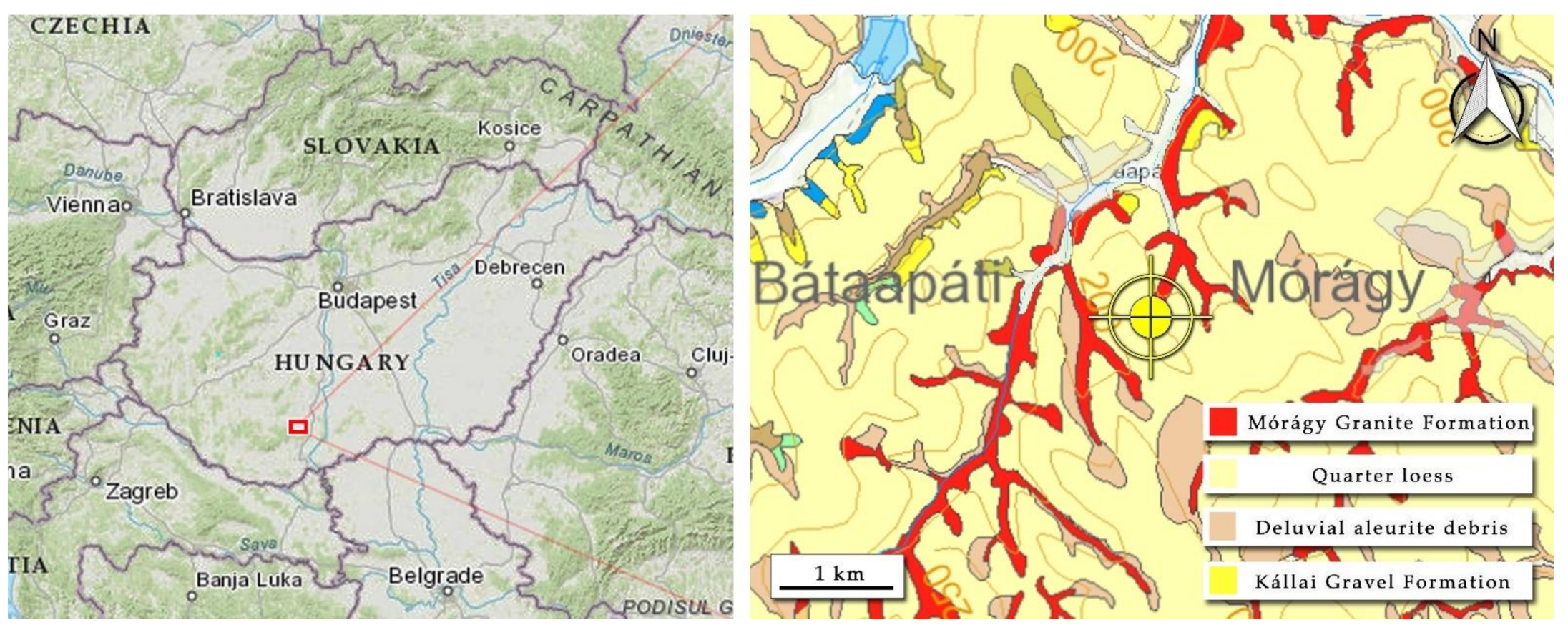
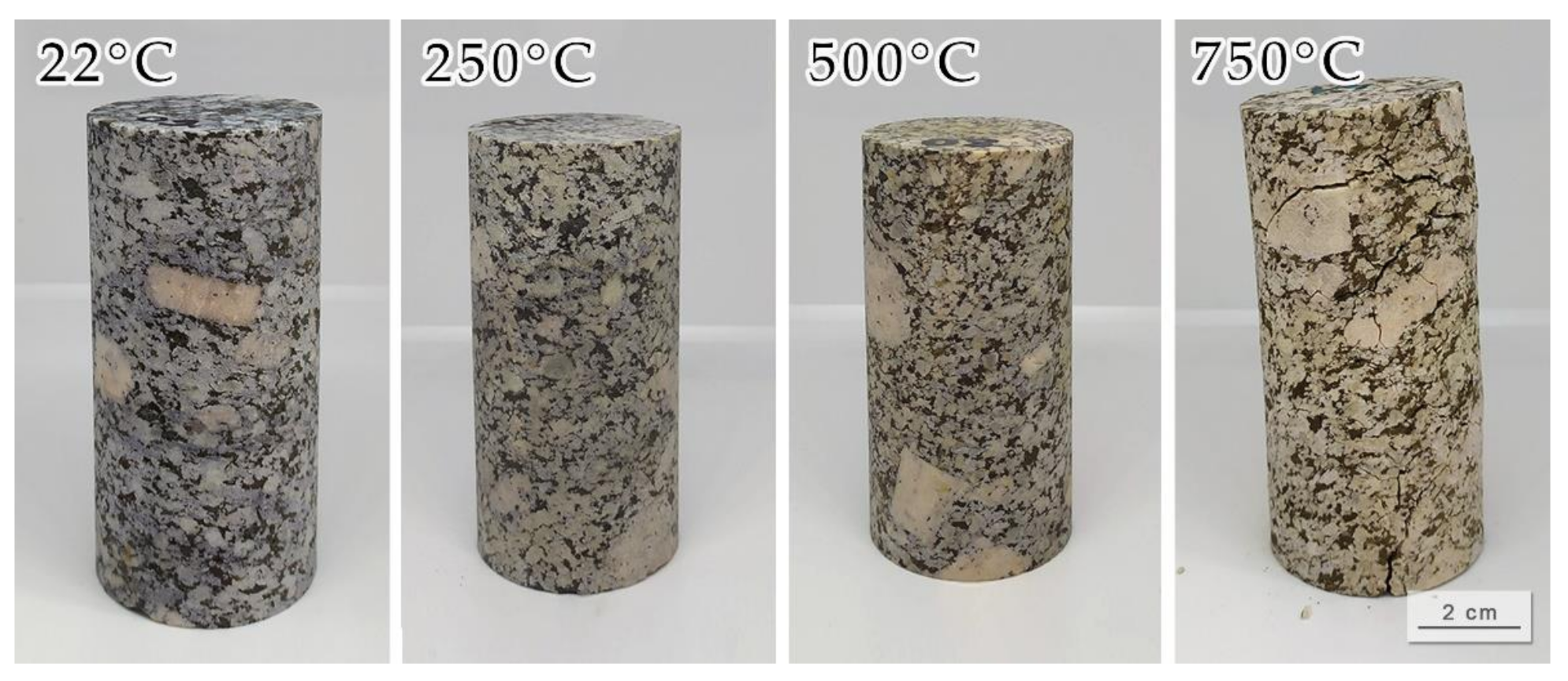
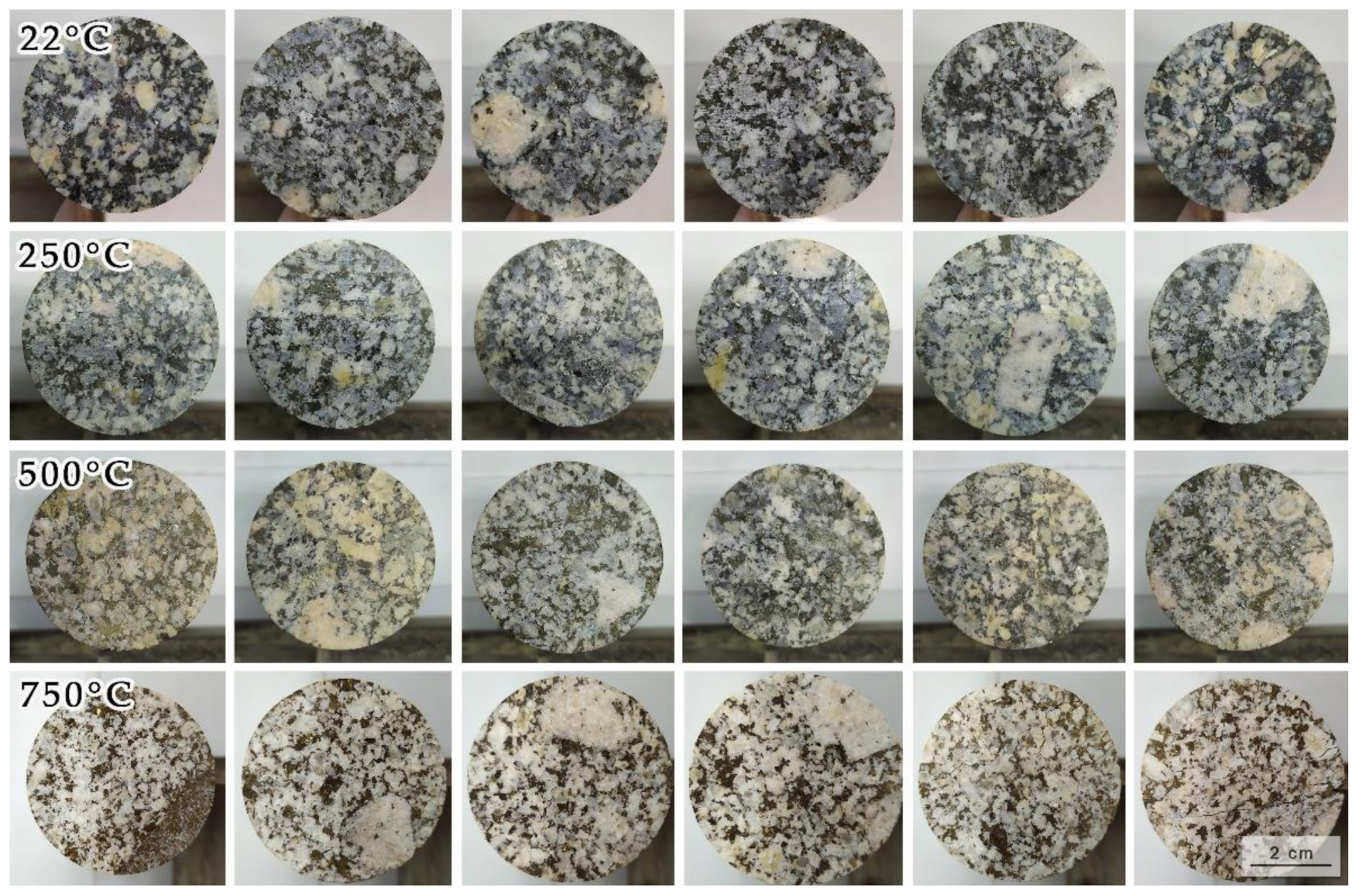
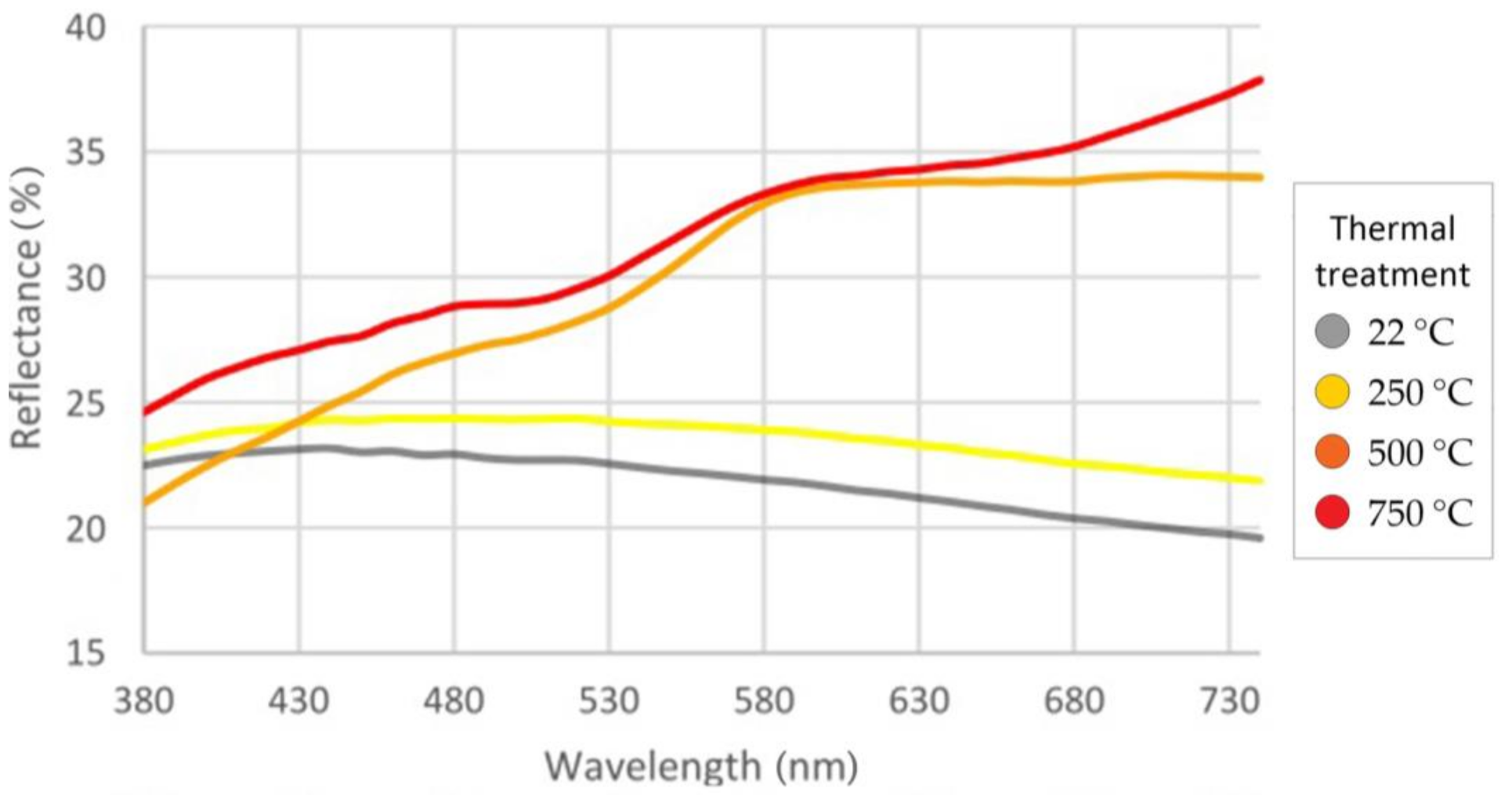
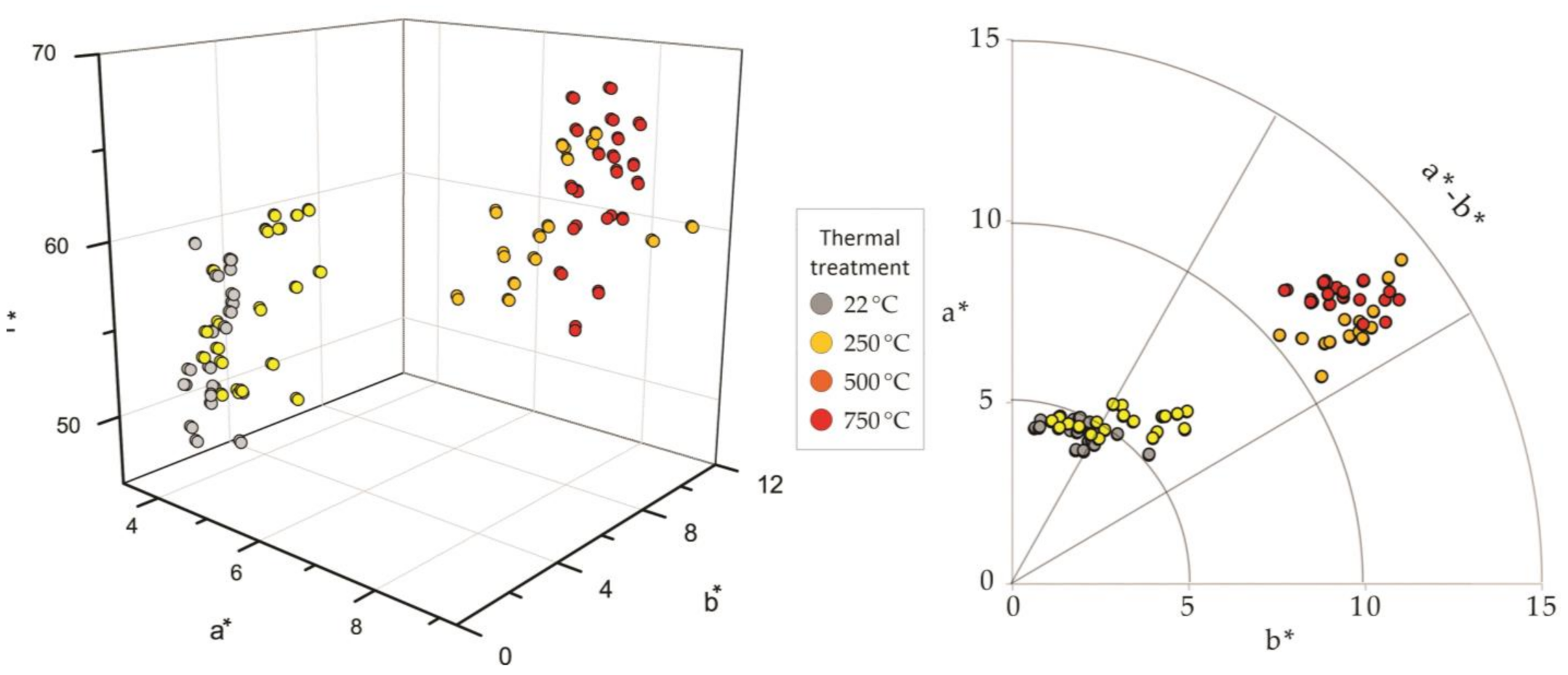
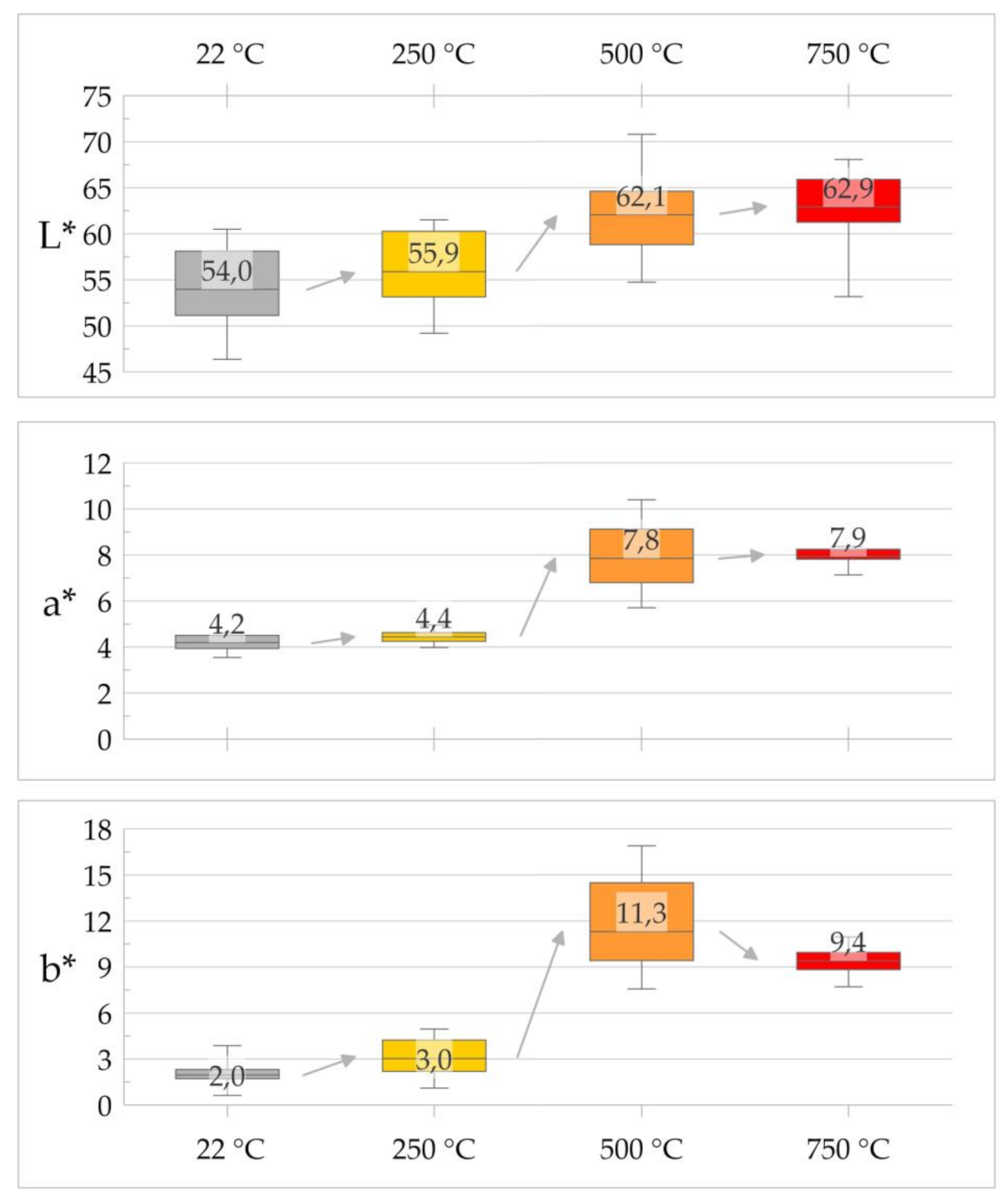
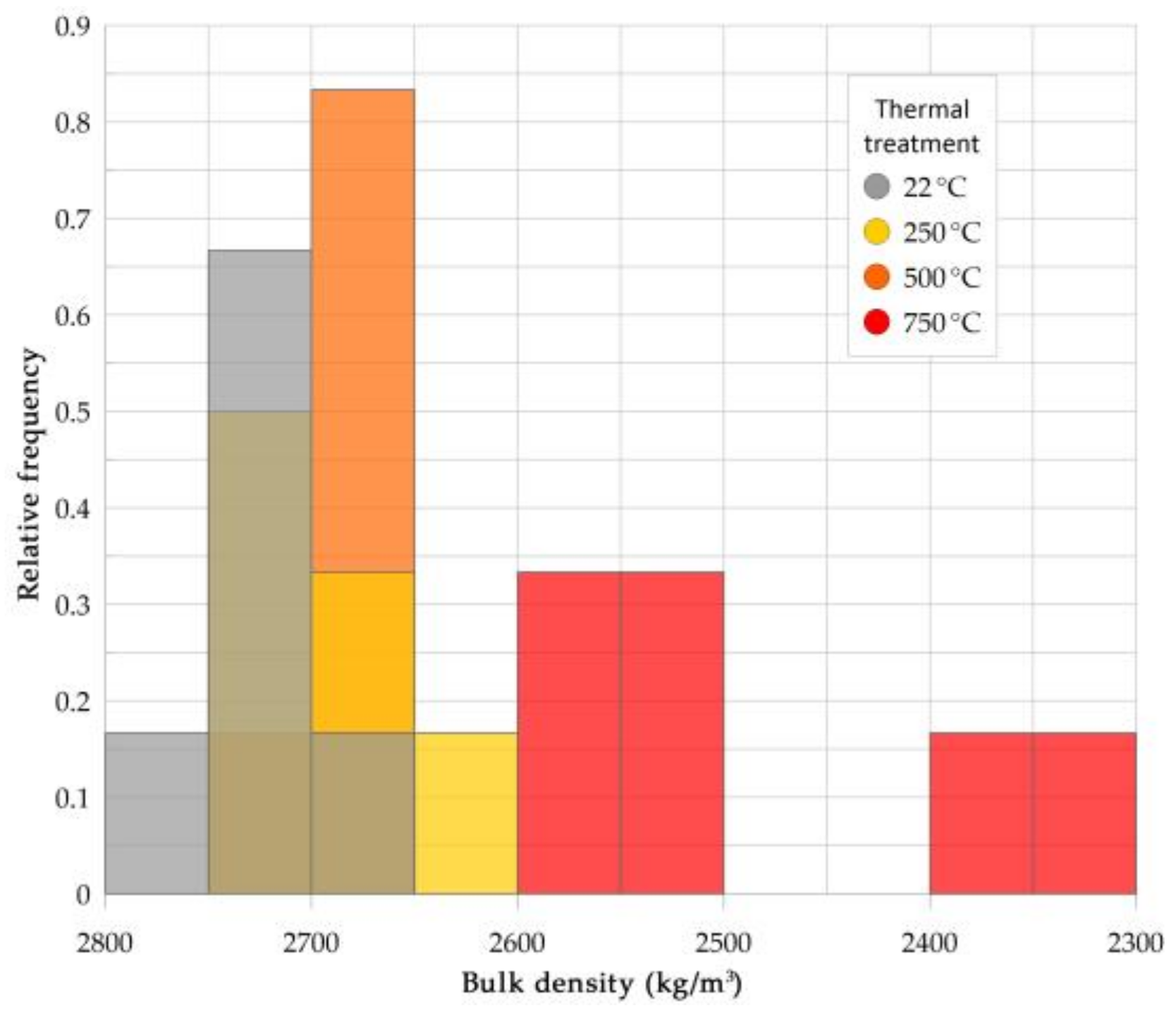


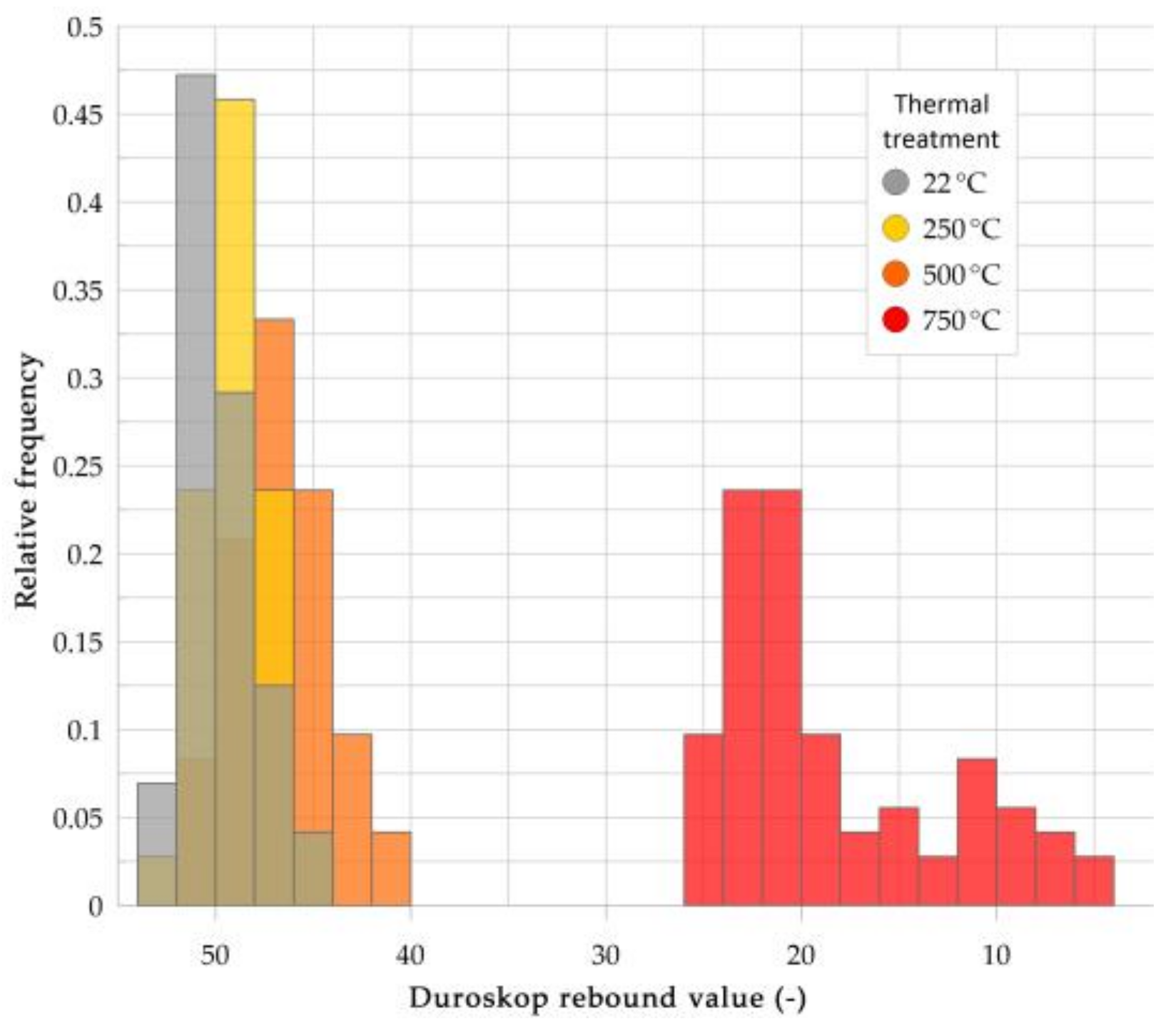

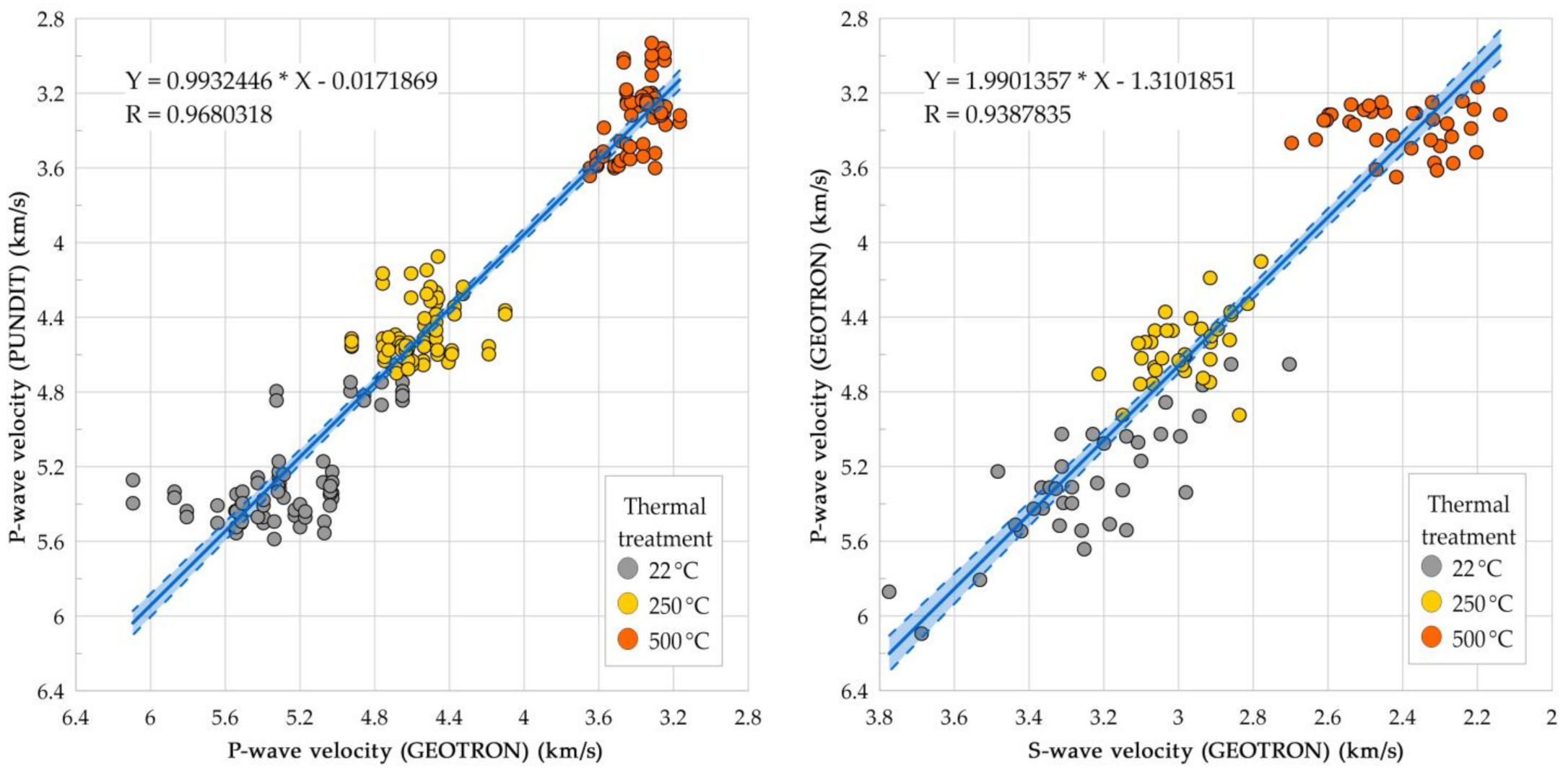

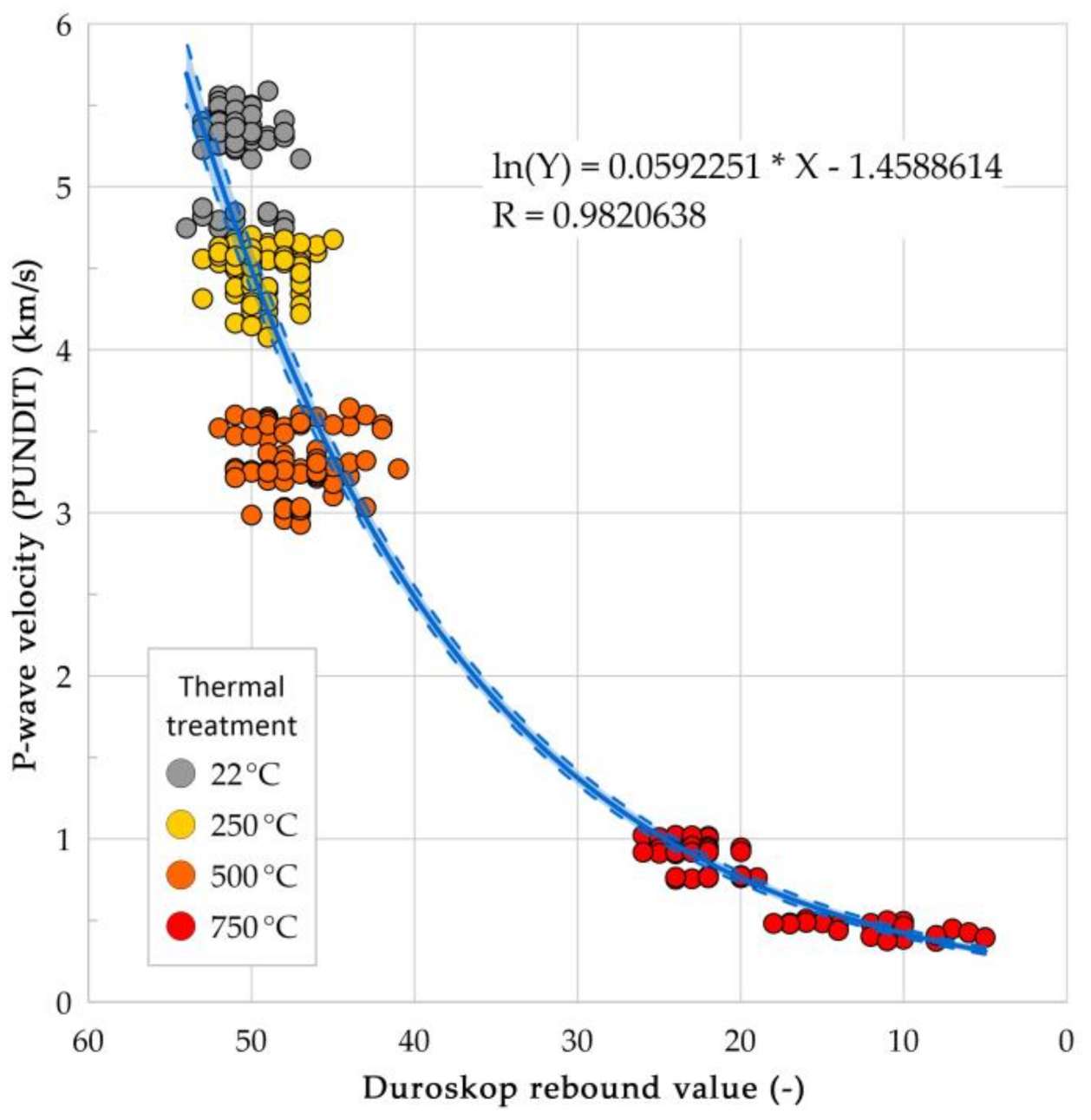
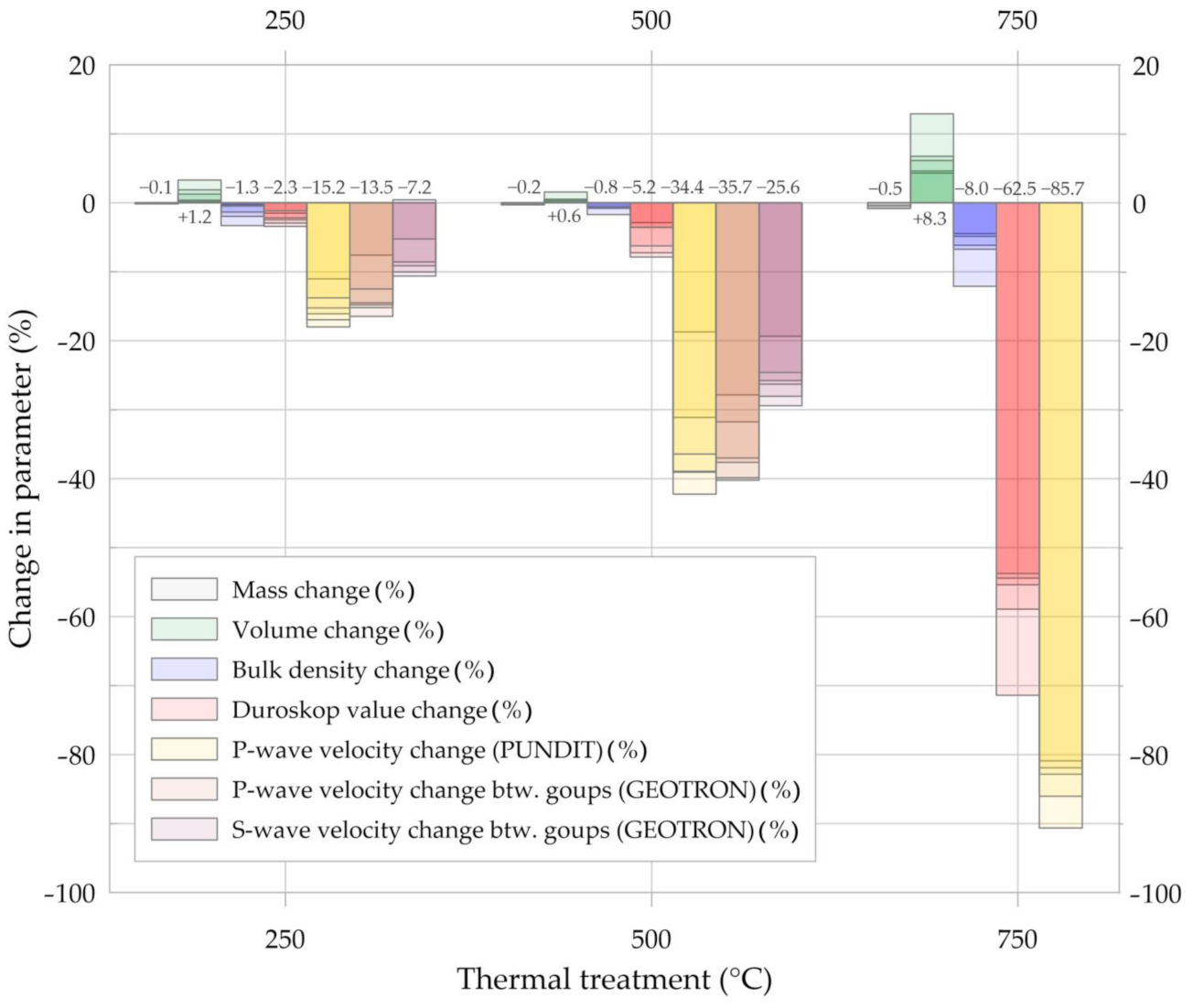
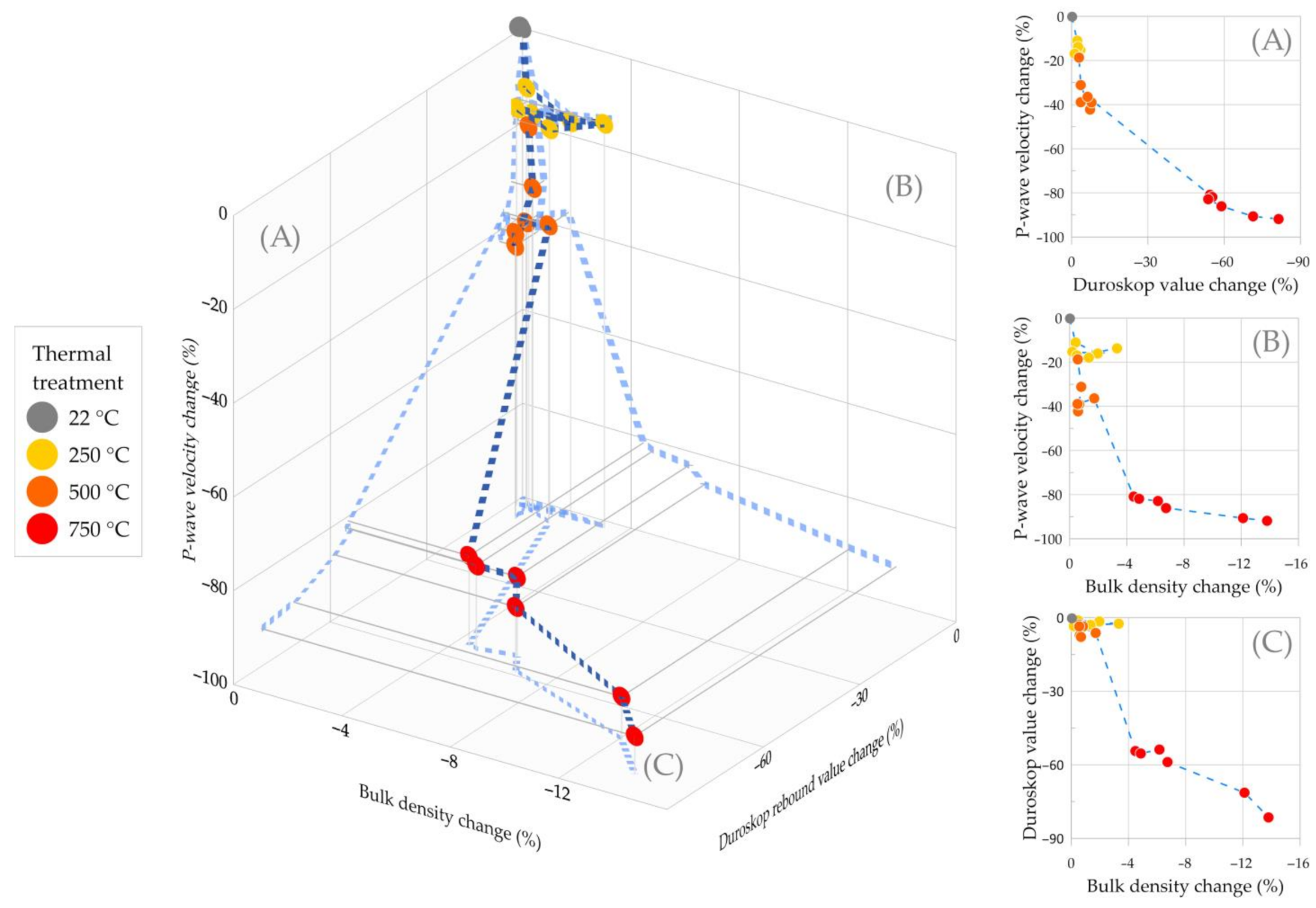
| Group | Bulk Density | P-Wave Vel. (PUNDIT) | P-Wave Vel. (GEOTRON) | S-Wave Vel. (GEOTRON) | Duroskop Value | Color Index |
|---|---|---|---|---|---|---|
| [EN 1936:2007] | [EN 14579:2005] | [-] | [-] | |||
| 22 °C | 6 | 72 | 36 | 36 | 72 | 20 |
| 250 °C | 12 | 144 | 36 | 36 | 143 | 20 |
| 500 °C | 12 | 78 | 36 | 36 | 144 | 20 |
| 750 °C | 12 | 144 | 0 | 0 | 144 | 20 |
| ∑ | 42 | 438 | 108 | 108 | 503 | 80 |
| Thermal Treatment Group | L* | a* | b* |
|---|---|---|---|
| (Std) | (Std) | (Std) | |
| 22 °C | 53.96 (4.10) | 4.19 (0.32) | 1.96 (0.74) |
| 250 °C | 55.88 (3.93) | 4.45 (0.27) | 3.03 (1.23) |
| 500 °C | 62.05 (4.60) | 7.85 (1.36) | 11.30 (2.94) |
| 750 °C | 62.92 (3.82) | 7.94 (0.33) | 9.40 (0.86) |
| Thermal Treatment Group | Bulk Density (Std) | Duroskop Value (Std) | P-Wave Vel. [PUNDIT] (Std) | P-Wave Vel. [GEOTRON] (Std) | S-Wave Vel. [GEOTRON] (Std) |
|---|---|---|---|---|---|
| (kg/m3) | (-) | (km/s) | (km/s) | (km/s) | |
| 22 °C | 2716.0 (23.6) | 51 (1.5) | 5.29 (0.24) | 5.28 (0.32) | 3.23 (0.22) |
| 250 °C | 2678.1 (34.0) | 49 (1.7) | 4.49 (0.15) | 4.56 (0.18) | 3.00 (0.12) |
| 500 °C | 2694.7 (27.1) | 47 (2.4) | 3.32 (0.19) | 3.39 (0.12) | 2.40 (0.15) |
| 750 °C | 2493.3 (125.0) | 19 (5.7) | 0.76 (0.23) | - | - |
Publisher’s Note: MDPI stays neutral with regard to jurisdictional claims in published maps and institutional affiliations. |
© 2021 by the authors. Licensee MDPI, Basel, Switzerland. This article is an open access article distributed under the terms and conditions of the Creative Commons Attribution (CC BY) license (https://creativecommons.org/licenses/by/4.0/).
Share and Cite
Németh, A.; Antal, Á.; Török, Á. Physical Alteration and Color Change of Granite Subjected to High Temperature. Appl. Sci. 2021, 11, 8792. https://doi.org/10.3390/app11198792
Németh A, Antal Á, Török Á. Physical Alteration and Color Change of Granite Subjected to High Temperature. Applied Sciences. 2021; 11(19):8792. https://doi.org/10.3390/app11198792
Chicago/Turabian StyleNémeth, Andor, Ákos Antal, and Ákos Török. 2021. "Physical Alteration and Color Change of Granite Subjected to High Temperature" Applied Sciences 11, no. 19: 8792. https://doi.org/10.3390/app11198792
APA StyleNémeth, A., Antal, Á., & Török, Á. (2021). Physical Alteration and Color Change of Granite Subjected to High Temperature. Applied Sciences, 11(19), 8792. https://doi.org/10.3390/app11198792







